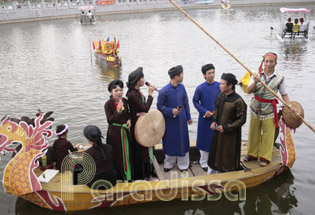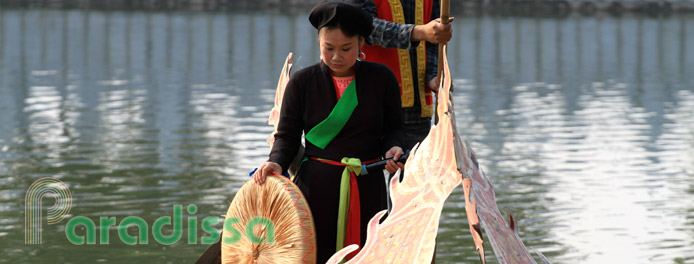Arts and performances show perception of people towards nature as well as the social life around them. Through arts and performances we understand the life and culture of a community at present as well as many years ago.
The Vietnamese has been cultivating their agrarian life starting in the Red River Delta for thousands of years. They have been in close touch with nature and they have passed on a rich culture from the ancient times.
From the Red River Delta in the north, the communities in Vietnam spread southward absorbing in and being influenced by various cultures from the East and the West. Reflecting its enriched and diversified culture, the Vietnamese arts and performances have always been intriguing to the discerning arts seekers.
Traveling in Vietnam, it requires no effort to find an art gallery or art objects. They can be easily found in high streets of Sai Gon or they can be found hiding themselves in the dark alleys of Hanoi Old Quarter. They can come in various forms such as paintings, embroidered tablecloth, a piece of wooden sculptures...
There are many traditional handicraft villages littered throughout the country carrying the long-lived arts culture for centuries. Many art travellers have found their long-looking-for treasures in Vietnam.
1/ Ca Tru
Ca Tru flourished in northern Vietnam in the 15th century. It was favorite entertainment among the dignitary people and scholars. There are normally 3 performers: a young female singer who also plays a Phach which is composed of 02 wooden sticks; a musician who plays a 3-stringed musical instrument called Dan Day and a drummer who plays a drum called Trong Chau.
2/ Hat Van
Hat Van, or Hat Chau Van, is a traditional folk music used mainly for spiritual purposes. Hat Van originated in the Red River delta in the 16th century, spreading later to the whole of the country. During its development Hat Van has absorbed in the bests of traditional folk music of different regions of Vietnam.
There are two kinds of Hat Van: Hat Tho and Hat Len Dong
2.1 Hat Tho
Worshiping Singing has slow, glorifying and serious rhythms.
2.2 Hat Len Dong
This is sung and danced to bring the singer/dancer who is usually a spiritual expert into connection with the supernatural world. After singing and dancing a while, the Dong Cot (singer, dancer) would turn into being the means for communication between the normal world and the supernatural one.
The core component of Hat Van is a Dan Nguyet – The Moon-Shaped Lute which leads the rhythms of the ceremonies, accompanied Dan Nguyet are a Phach ( 2 pieces of bamboo or wood), a Trong Chau (drum), a Chieng (Bronze Gong), a 16-stringed zither and a flute.
3/ Hat Xam
Hat Xam, or Songs of The Blind Artists took its form from the 13th century. Tran Quoc Dinh, a prince, a son of King Tran Thanh Tong was believed to be the founder of Hat Xam. Tran Prince was blinded by his brother in jealousy of his talents. Dinh loved singing and he had a talent of music. He invented a musical instrument composed of a rattan cord which plays very deep and sorrowful tones telling his life expressing his sadness.
The instruments for the Xam song are a two-stringed violin and two "Xam" drums. The Xam singers travel in groups from 2 to 5 and sing their songs telling their life in the public.
4/ Lullabies
Lullaby Music is of folk music tunes to lull little babies to go to sleep. The rhythms are lyrical, soft and quiet. The songs usually express someone's feelings such as missing away-from-home husband, homesickness, love for the country or for someone...
5/ Quan Ho
Quan Ho is the traditional music of former Kinh Bac Region, 10 km north of Ha Noi. Quan Ho was the way the Kinh Bac People entertained themselves when working in the paddy fields. There are many theories about the name of the music and no one seems to have a firm ground for the origin of the name.

Quan Ho Songs performed at Do Temple, Dinh Bang Village, Bac Ninh Province
The rhythms of Quan Ho is unique, lyrical and sweet. The words of the songs are folksy and Quan Ho is the way the Kinh Bac people express their emotions, sentiment, love...
Quan Ho can be performed by a solo singer and can be performed by 02 groups of male and female singers. Traditionally, Quan Ho was the way the girls and boys challenged one another and the way for them to find the right match of their life.
Nowadays, Quan Ho is performed at special occasions such as weddings, festivals, ceremonies...in the once-Kinh Bac Region.
Quan Ho Bac Ninh
Quan Ho Songs performed at Do Temple, Dinh Bang Village, Bac Ninh Province
6/ Ly Songs
Ly Songs are sung in all regions of Vietnam, but more popular in the south. Ly Songs show different aspects of the Vietnamese life from work, relations, love... Ly Songs have simple melodies which can be joyful or melancholic. The words of Ly Songs are simple and folksy.
7/ Cai Luong
Cai Luong was started in southern Vietnam in the late 1920s. Cai Luong is the combination of southern Vietnam folk music and western dramas. The music is normally sweet, soft and somewhat melancholic.
8/ Cheo
Cheo is a traditional entertainment form among the Vietnamese. It's the creative combination of folk tales, music and performances. Cheo dramas tell stories of heroes, daily life, love stories... The gestures, make-ups and language of the Cheo performers have been accumulated from the bests of the Vietnamese culture for centuries.
In most Cheo dramas we can find all romance, tragedy and comedy. Cheo can be performed in a theatre or in the community house of a village. At a Cheo performance, the spectator always find a part of their life in the drama.
9/ Tuong
Tuong is a more formal entertainment form compared to Cheo. Both have dramas about different aspects of life. Cheo expresses things in a way of the common people and Cheo uses the arts more easily understood to common people than Tuong. The make-ups, the gestures and the language of Tuong are all much more formal and more symbolic than Cheo. While Cheo dramas could be about anything and anyone, Tuong dramas are mostly about things of the dignitary class. Tuong uses a lot of metaphor in the gestures, emotions and make-ups of the actors.
10/ Water Puppetry
Water Puppetry originated in the Red River Delta in the 11th century. This was the way the inhabitants of the Red River Delta entertained themselves during the flooding days. Nowadays water puppet is performed in theatres or at a village pond. The stage is simple with cloth and a little pond. The spectators sit around the pond. The puppets are made from fig wood, coated with lacquer paint and controlled through a string and pole hidden in water. The pole and strings are handled by the puppeteers who stand hidden and waist-deep in the water.
Water Puppetry shows different aspects of life, but normally the daily life of the Red River inhabitants. The puppets are made full of characters and often never fail to bring the spectators into laughter.
If you are interested in discovering more of the Vietnamese arts and traditional or contemporary performances, please contact Paradissa for a customized tour which fully meets your requirements.
